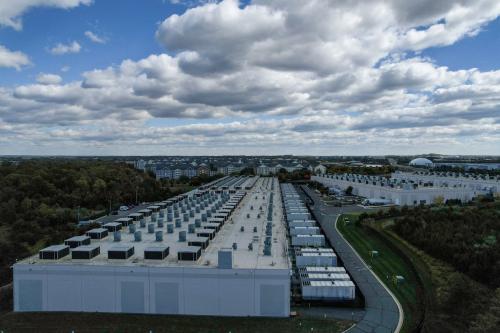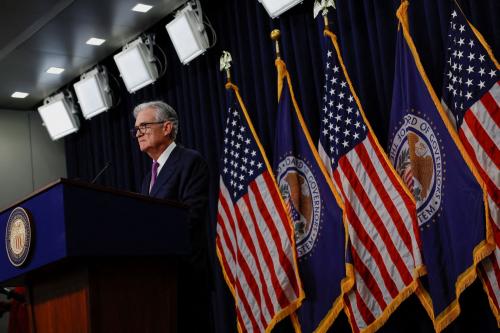Interstate migration has declined in the U.S. in recent decades, suggesting that workers are less likely to move in order to find employment. Such a trend would have significant policy implications for state and local governments, as well as at the federal level. But new research by Andrea Foschi, Christopher L. House, Christian Proebsting, and Linda L. Tesar suggests that it isn’t workers who have changed as much as differences in regional economies. On this episode of the Brookings Podcast on Economic Activity, House and Tesar join Brookings Senior Fellow Tara Watson to discuss the findings of their new paper, “Should I Stay or Should I go? The response of labor migration to economic shocks.”
- Listen to the Brookings Podcast on Economic Activity on Apple, Spotify, YouTube, or wherever you like to get podcasts.
- Learn about other Brookings podcasts from the Brookings Podcast Network.
- Sign up for the podcasts newsletter for occasional updates on featured episodes and new shows.
- Send feedback email to [email protected].
Transcript
[music]
EBERLY: I’m Jan Eberly, the James R. and Helen D. Russell Professor of Finance at Northwestern University.
STEINSSON: And I’m Jón Steinsson, Chancellor’s Professor of Economics at the University of California, Berkeley.
EBERLY: We’re the co-editors of the Brookings Papers on Economic Activity, a semi-annual academic conference and journal that pairs rigorous research with real-time policy analysis to address the most urgent economic challenges of the day.
STEINSSON: And this is the Brookings Podcast on Economic Activity, where we share conversations with leading experts on the research they do and how it will affect economic policy.
EBERLY: Throughout American history, workers have followed the money. When new opportunities or industries crop up, whether it’s a gold rush or construction developments or new factories, people will move to that area to reap the benefits. But in the last half century, interstate migration has dropped substantially.
On today’s episode, the interview will focus on the question of whether workers have become less willing to move for professional opportunities. That is, whether they’ve stopped following the money.
The new research, “Should I Stay or Should I Go? The Response of Labor Migration to Economic Shocks,” was authored by Andrea Foschi, Chris House, Christian Proebsting, and Linda Tesar.
STEINSSON: Yes, most economic booms and downturns affect some areas of the country more than others. For example, the Rust Belt was hit particularly hard during the recession around 1980, while the so-called Sand States – Arizona, California, Florida, and Nevada – were hit particularly hard by the housing downturn during the Recession of 2008.
In a large country like the United States that has a single currency, monetary policy is a one-size-fits-all type of policy and cannot cater to the needs of a particular area. This means that the economy must rely on other adjustment mechanisms such as the movement of people from places that are doing poorly to places that are doing relatively well.
Some recent research has suggested that the dynamism of the economy when it comes that these population flows between places has fallen. The present paper seeks to throw new light on this question.
EBERLY: Now we’ll hear from Tara Watson, Director of the Center on Social Dynamics and Policy at Brookings, in conversation with Linda Tesar, Alan V. Deardorff Collegiate Professor of Economics, and Chris House, Professor of Economics and Director of Graduate Studies, both at the University of Michigan.
WATSON: Thanks, Jan and Jón. And thank you so much to Linda and Chris for joining our podcast today.
I was very interested to read the paper and think about how local labor markets respond when there’s a shock, either positive or negative shock. So, let’s say we all know about the example of Detroit where the manufacturing industry took a hard hit. What happens to Detroit and to people that used to live in Detroit after that fact? Or we also think of examples like North Dakota where there was an oil boom, lots of people moved there.
So, maybe we’ll start with you, Chris, if you could start by talking about the responses that a local economy could have when there’s a shock like this that doesn’t come from something, a decision they made or something they did, but sort of comes down from the sky. How do local economies respond to that?
[3:35]
HOUSE: Thanks for having us on the podcast. Yeah, you’re right. Regions can react to changing economic conditions in a variety of ways. If labor demand increases, then businesses in those regions, they typically start looking for new workers and where are these workers going to come from? So they could come from the unemployed workers in the region itself. Local pool of unemployed workers. It could be that you tempt people who previously weren’t actively engaged in the labor market to now start working. This is what labor economists sometimes refer to as the labor force participation rate.
Or it could be that you tempt people to relocate, to move into a region that’s doing particularly well to move in to that region from somewhere else, that is, labor could migrate. The North Dakota example that you mentioned, that’s a very, very dramatic example. They find oil deposits there and then in the towns nearby you had populations in those towns just skyrocketed as these new workers arrived.
Of course, you can have exactly the opposite reaction as well. So, you mentioned Detroit. Another example might be as, as let’s say the steel industry in the United States has contracted gradually, there’s going to be a lot of towns in Pennsylvania that have experienced a steady outflow of workers. Those people and their families, they all leave just because there aren’t any jobs there anymore.
Yeah, that’s really what the paper is all about. It’s about the extent to which workers take this third adjustment margin, changing their location, migrating from one region to the next, looking for better economic conditions.
WATSON: Yeah, and I’ve seen several presentations over the years where there’s, I would say, a fair amount of hand-wringing from economists about the declining migration patterns in the U.S. People are less likely to move than they used to be, it seems.
So, Linda, maybe you could talk us through the work that’s existed on this topic and related topics and how that sets up the jumping off point for what you’re going to do in this paper.
[5:45]
TESAR: Yeah, I think the jumping off point for us was a Brookings paper, actually, by Blanchard and Katz in 1992. And they do a similar kind of exercise where they look at employment growth at the state level, and they find that states that experience relatively high employment growth also tended to have low unemployment, high wages, and positive in migration. And in fact, one of the takeaways of their paper that I think was kind of the standing wisdom for a long time was that labor migration was actually the main way that regions adjusted to shifts in labor demand.
I think things shifted over time and in part it shifted over time because when we look at different subsamples of data, which we do in our paper, too, you can see that that response of labor mobility has changed somewhat over time, although when we take the sample of data up to the most recent data we basically reaffirm the Blanchard and Katz finding that about 60% of the employment response can be explained by the labor migration response.
So, I think we kind of reaffirm what Blanchart and Katz do. We extend what they do because we have more data, but also, we look at a number of different, what we call identified shocks, which we could talk about more, but that’s sort of the launching point for our paper.
WATSON: Great, so maybe we’ll just jump right into those identified shocks.
So, we don’t want to get too technical for our audience here, but I do think it’s interesting to think about how we might measure a change in labor demand because we have a little bit of a chicken and egg problem here, right? If an economy is doing well, people move there, but also, maybe the fact that people are moving to a place might cause the local economy to do well or to do poorly if they’re moving away.
So, it’s important to separate out the chicken from the egg here and economists have ways that they’ve tried to do this, including the Blanchard and Katz paper that you mentioned and others. So, maybe you could tell us a little bit about the specific shocks that you use or how you try to get at this causal effect of a labor demand shock.
[7:51]
HOUSE: So you’re absolutely right. What you’re describing is a chicken and egg problem. This is a problem that runs through all of empirical economics. All of the graduate students at the University of Michigan are constantly looking for good natural experiments or good instruments to try to tease out a causal effect to get around this chicken and egg problem.
Our approach is to use what economists refer to as instrumental variables. This is a statistical technique that focuses on specific changes or shifts in the economy that we think are proxies for changes in regional labor demand. So one of them you might guess from your earlier comments about the auto industry and its effect on labor demand in Detroit. One of them that we use is an industry shift measure where we look at changes in aggregate industry demand and then look to see whether regions that specialize in that industry like Detroit experience a shift in labor demand.
Another instrument that we look at is to look at regional changes in demand caused by national changes in military spending. So, there’s some areas in the country. If you think that the Department of Defense decides to spend a whole bunch of money on fighter jets, well, who makes fighter jets? Boeing. And where are they located? They’re located in the Pacific Northwest, and so labor demand in the surrounding areas will be more affected than it would be compared to Kentucky, for instance.
We also look at the response to labor markets following the so-called China shock, which is attached to China’s entry into the World Trade Organization. As China has expanded, imports from China have put a lot of pressure on industries that compete in those products and you can identify regions of the country that are more heavily affected by the China shock than those that aren’t.
And the last thing we use is, we use a measure based on house price changes. This was following the Great Recession when the housing market collapsed. House price changes were not experienced uniformly and evenly across the country. There were some regions where the effects were particularly pronounced and you can also use that as an instrument.
Fortunately for us, all of these instruments point in the same direction. Linda just mentioned that in the long run, roughly 60% of the relative change in employment in a region, whether that’s at the state level or at the county level or commuting zone level, roughly 60% of the change in employment is accommodated by changes in in- or out-migration, and that seems to be a common estimate across all the labor demand shocks that we look at.
WATSON: That’s surprising in a way to me because these shocks all happened in different industries or two different industries. They happened at different times. So, it’s pretty remarkable that that’s so persistent as a finding.
[10:58]
HOUSE: I think your reaction is absolutely correct. We should point out that, while that 60% figure is common across all the shocks, the actual employment responses are different.
So, for the China shock, this is actually a very, very significant shock for regions that are facing that type of import competition and the employment response there is actually different than the employment response following the house price shock.
So I guess the way you would think about Linda’s 60% figure is to say, once I tell you that there’s been an x percent change in employment, 60% times x is accounted for by migration. But the actual change in labor in employment – the overall change in unemployment – does differ across these shocks as I think you would anticipate.
WATSON: So Linda, one way that things might differ is some of the shocks we’re talking about are positive and some are negative, as we’ve talked about. Could you talk about what you found when you tried to think about those as two distinct phenomenon?
[12:01]
TESAR: Absolutely. So, what we find, and this is consistent with what other people have found as well, looking at this data, is that most of the change in population comes from changes in the number of people coming in rather than changes in the number of people going out.
So, one way to think about that is it’s almost as if there’s a set of workers that are potentially mobile, and when shocks come along and they’re thinking about where to relocate, they’re the ones that make the decision where to go, and it’s this group that makes most of the adjustment. Following a localized economic downturn, there’s an increase in out-migration, but it’s not as big as this in-migration effect. And I think it’s important to emphasize that this was something that we saw during the Great Recession, and it led to some kind of difference as an interpretation of the data.
And what we saw there was a decline relative to trend in people moving from places like Michigan or Ohio to places like California or Arizona. Typically, over the long span of history, people have been leaving the Midwest to go to sunnier places like California and Arizona. But what you saw in the aftermath of the Great Recession is that California and Arizona were hit particularly hard by the real estate crisis. And this had negative spillover effects to the local economy there, and this discouraged people from relocating to Michigan.
So, it’s really important to disentangle the in-migration and the out-migration, and to disentangle the movements around trend relative to trend.
WATSON: That’s very interesting. I also saw in your paper that it’s largely driven by young people moving, so that seems consistent with this idea that people are just coming to an area because they’re looking across the country and thinking about where’s the right place for me to go right now.
[13:49]
TESAR: That’s correct. Now, to be clear, our study, at least at this point in time, we don’t track individual workers, so we can’t say that this is what educated workers do. But what we can do is we can say, in counties or locations where a higher fraction of the population has higher education, higher incomes, or other characteristics, we can characterize to what extent do those counties have different or those regions have different labor mobility responses relative to other regions.
WATSON: I was also going to ask you about one thing that wasn’t in the paper, probably for the same data limitation you just mentioned, which is, I’m personally very interested in immigrants moving around the country internally, and George Borjas has this famous line about immigrants greasing the wheels of labor market, where immigrants are doing a lot of the mobility. And in contrast to some of what we’ve heard about more educated U.S. born people, for immigrants it seems that regardless of education, immigrants tend to be more mobile.
And I wonder how you think that the importance of immigrants in our labor force generally contributes to what you’re finding in the paper.
[15:00]
HOUSE: Yeah, that’s a great question, and it’s not surprising that I think a lot of people think exactly about this question because immigration is just constantly in the news now.
As you said, our paper doesn’t focus directly on the distinction between international immigrants to the United States and how their migration patterns within the United State differ from workers that are born in the United States. We don’t have that breakout. I think Linda mentioned a moment ago that, on the whole, for the data that we do have, it’s the workers that are more highly educated, higher income, to an extent, workers who are in cities. Those are the workers who seem to be most mobile, most likely to respond to these economic fluctuations, these regional economic changes, which is not to say that lower-income, lower-educated, urban people don’t respond. They do; they just respond a little bit less.
Just speaking for myself, I suspect that most international immigrants are indeed more mobile, more responsive to economic shocks. And this is absolutely something that we’re going to be looking at in the very near future and I think other researchers should be looking as well. It’s a very important component of our work, which we haven’t resolved at this point.
WATSON: As we go back to the big picture of this paper, I’m hoping that you each can tell me what you hope our listeners today will take away. What would you like them to go home and talk about at their dinner table tonight? What did they learn from this work?
[16:32]
TESAR: I think there’s two things. One is, it’s going to sound nerdy, but I’m going to try to make it not sound nerdy, is that it’s important to distinguish between migration patterns and trends from what we call the elasticity of the migration response.
So, one could have long run trends in population movements, but we’re trying to distinguish from that: what is the responsiveness and we’re looking at a business cycle frequency to shifts in response to shocks. And I think the two things can be going on at the same time. You can have long run trends that are pushing one way and then you can ask around those long run trends, what’s the responsiveness.
And what we think we find in our paper is despite the fact that we’ve seen the long run migration rate or the movement across state lines, for example, falling over time, we’re seeing a fairly robust and constant elasticity. In other words, the responsiveness of the market to localize shocks seems to be fairly constant. So kind of reconciling those two things is what we think people should have in mind and what we hope our paper contributes to.
And I think more broadly, you know, when we think forward to what we want to better understand is, the U.S. economy has been changing over time: our industrial structure has been changing over the time, manufacturing is less important than it used to be, services are more important. And that’s going to mean the kinds of shocks that the economy experiences are going to look different.
And so, we want to better understand, as the economy is shifting over time, what’s the role of labor mobility and the ability of the labor market to adjust? How has that changed over time?
WATSON: I guess an extreme version of that is if there comes a point where we’re all working from home then we’ll be wherever they are, and they don’t have a lot of incentive to move.
[18:25]
TESAR: Yes, and woe to the researcher that’s going to try and track where we work and how we work and the location of our work. That’s going to be really tough going forward.
HOUSE: Yeah, just incidentally, I should mention our data actually leaves off just as the pandemic drops on us. So, people are constantly asking about remote work, and I expect that the data coming up, the next batch of data, will reflect some pretty big changes, but we don’t have them in our data just at this point yet.
WATSON: Good to know. Is there anything else you wanted to add, Chris, on the big takeaways for our listeners?
[19:02]
HOUSE: Not so much. I think Linda covered the main thing. Our paper certainly is not contesting the idea that migration rates have dropped. They have.
What our paper is pointing out is that it’s the reason, how you react to that drop in the migration rate, that we kind of are adding to. I think a lot of people, when they saw the decline in migration rates, assumed that it was a decline in the sensitivity of workers to differences in regional economic conditions, that workers were becoming more reluctant to move. Or it could be that the pressures that workers are facing to move from one region to the next, the incidence of these regional shocks, that those shocks have actually gone down.
And our work suggests that it’s actually more the latter. The workers seem to be just as responsive to wage differentials and the availability of jobs from one region to the next. They seem to just as reactive and responsive to those differences today as they were in the past. It’s just that the regional differences themselves have dropped in significance.
WATSON: Great. Well, thank you both so much for joining us today.
HOUSE: Thank you.
TESAR: Thank you
[music]
STEINSSON: Once again, I’m Jón Steinsson.
EBERLY: And I’m Jan Eberly.
STEINSSON: And this has been season six of the Brookings Podcast on Economic Activity. Thanks to our guests for this great conversation, as well as a big thanks to all the BPEA authors and Brookings experts who joined the podcast this season. Be sure to subscribe to get notifications when we launch season seven in October 2025.
EBERLY: The Brookings Podcast on Economic Activity is produced by the Brookings Podcast Network. Learn more about this and our other podcasts at Brookings dot edu slash podcast. Send feedback to podcasts at Brookings dot edu and find out more about the Brookings Papers on Economic Activity online at Brookings dot edu slash B-P-E-A.
STEINSSON: Thanks to the team that makes this podcast possible: Fred Dews, supervising producer; Chris Miller, co-producer; Gastón Reboredo, co-producer and audio engineer. Show art was designed by Katie Merris and promotional support comes from our colleagues in Brookings Communications.
The Brookings Institution is committed to quality, independence, and impact.
We are supported by a diverse array of funders. In line with our values and policies, each Brookings publication represents the sole views of its author(s).











Commentary
PodcastDo American workers still move to find work?
Listen on
Brookings Podcast on Economic Activity
June 12, 2025